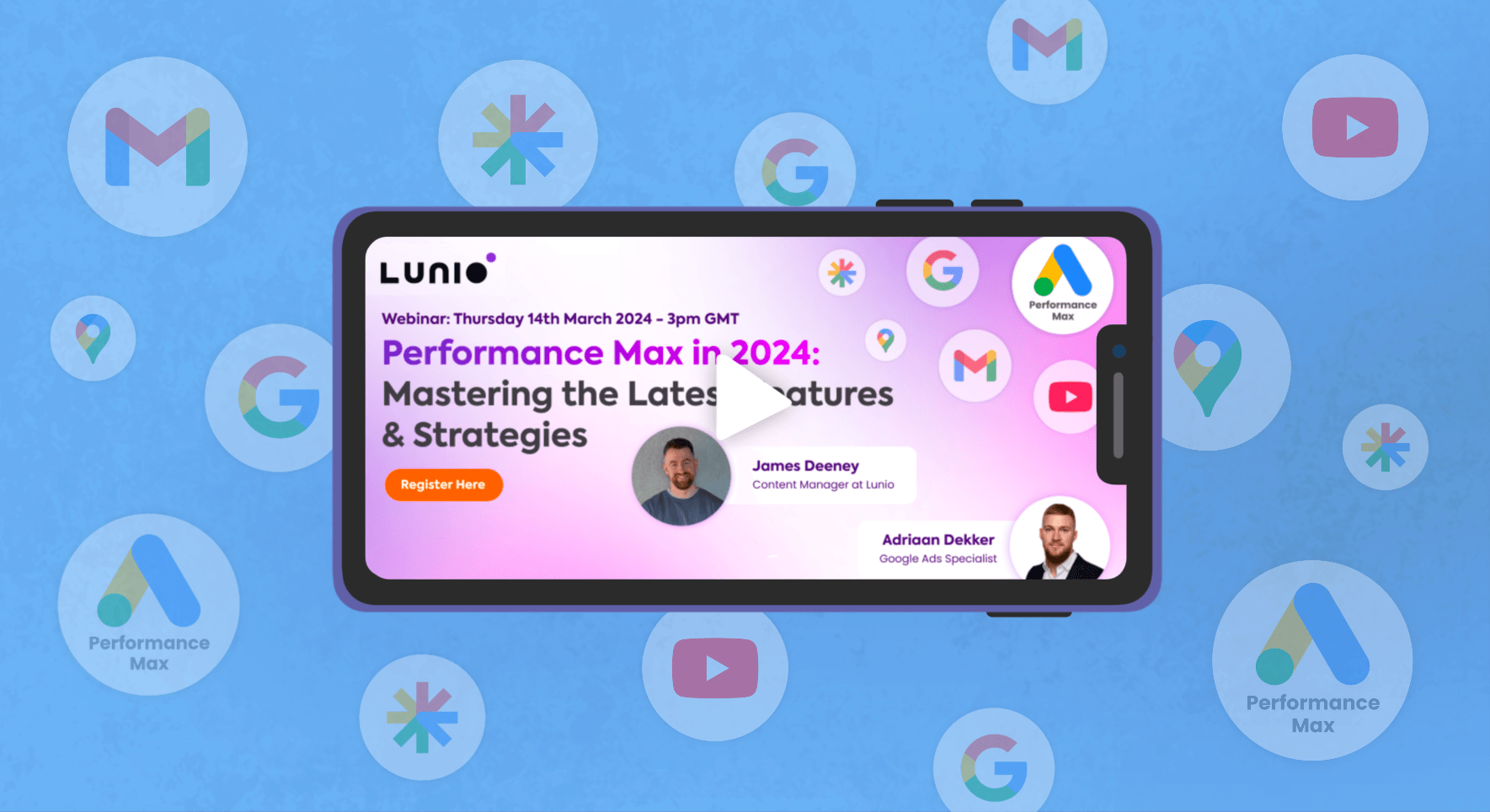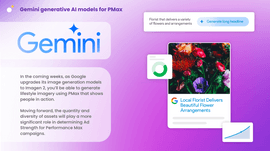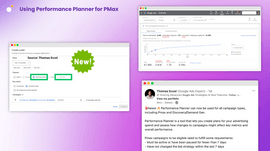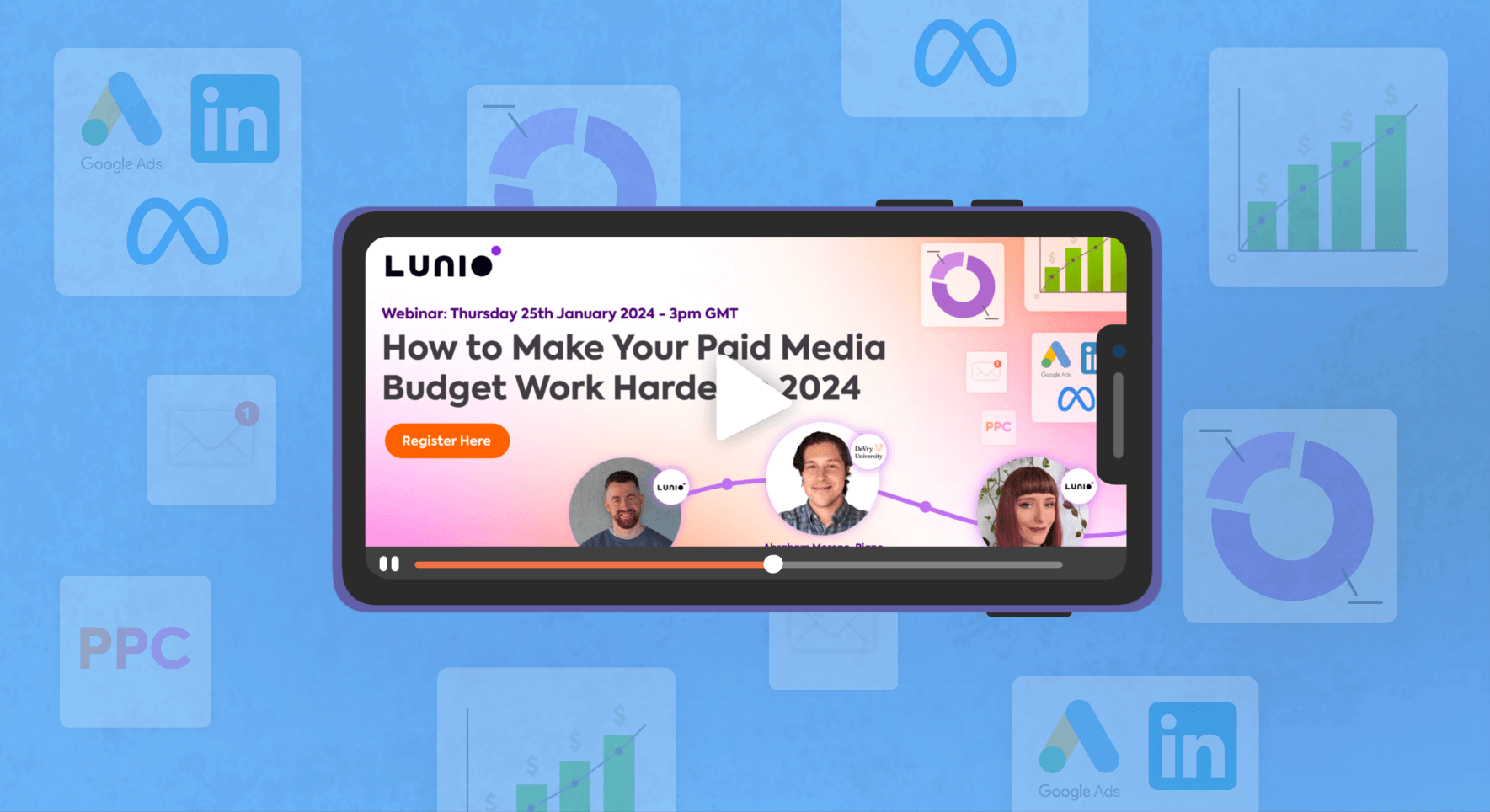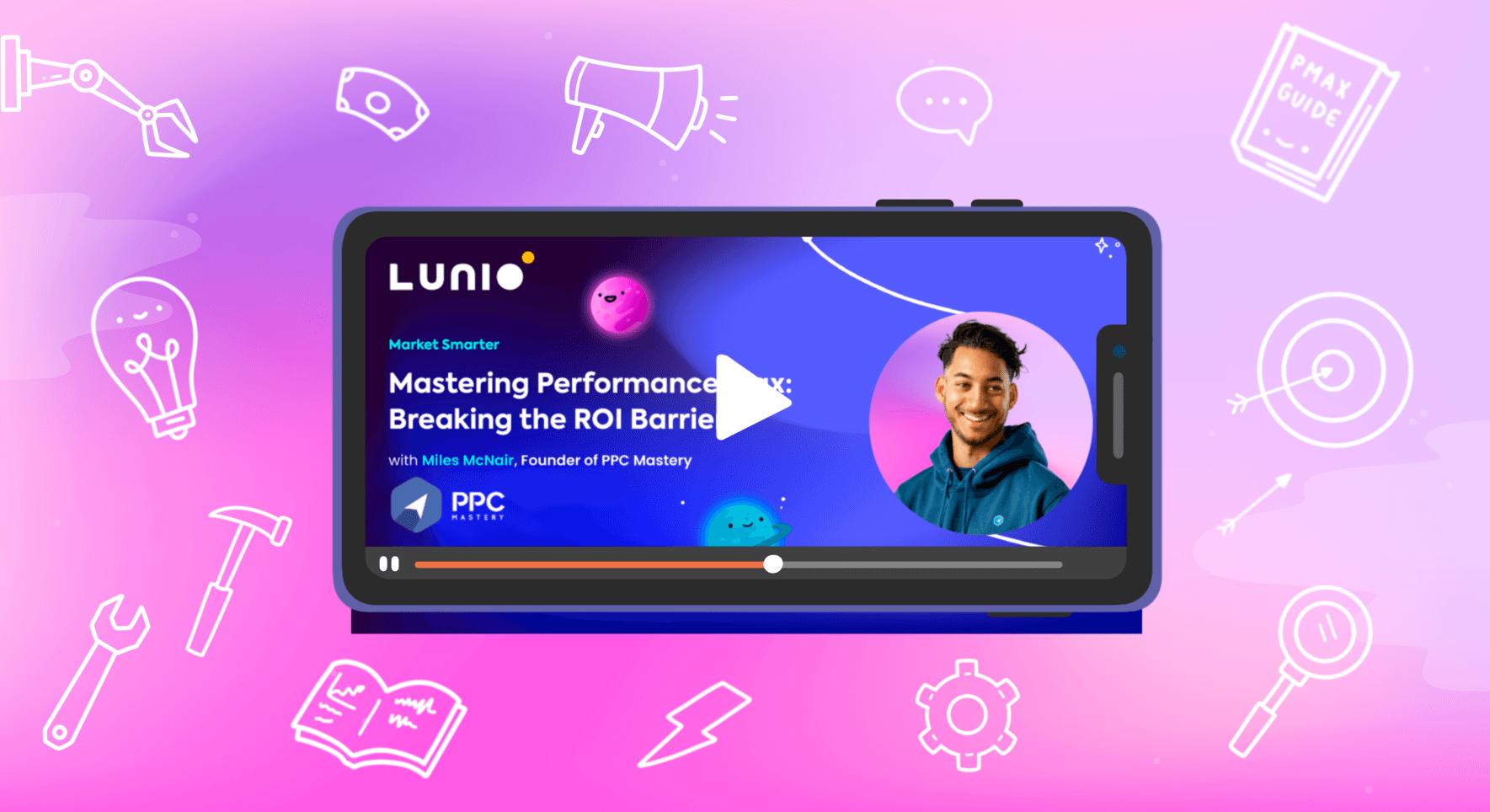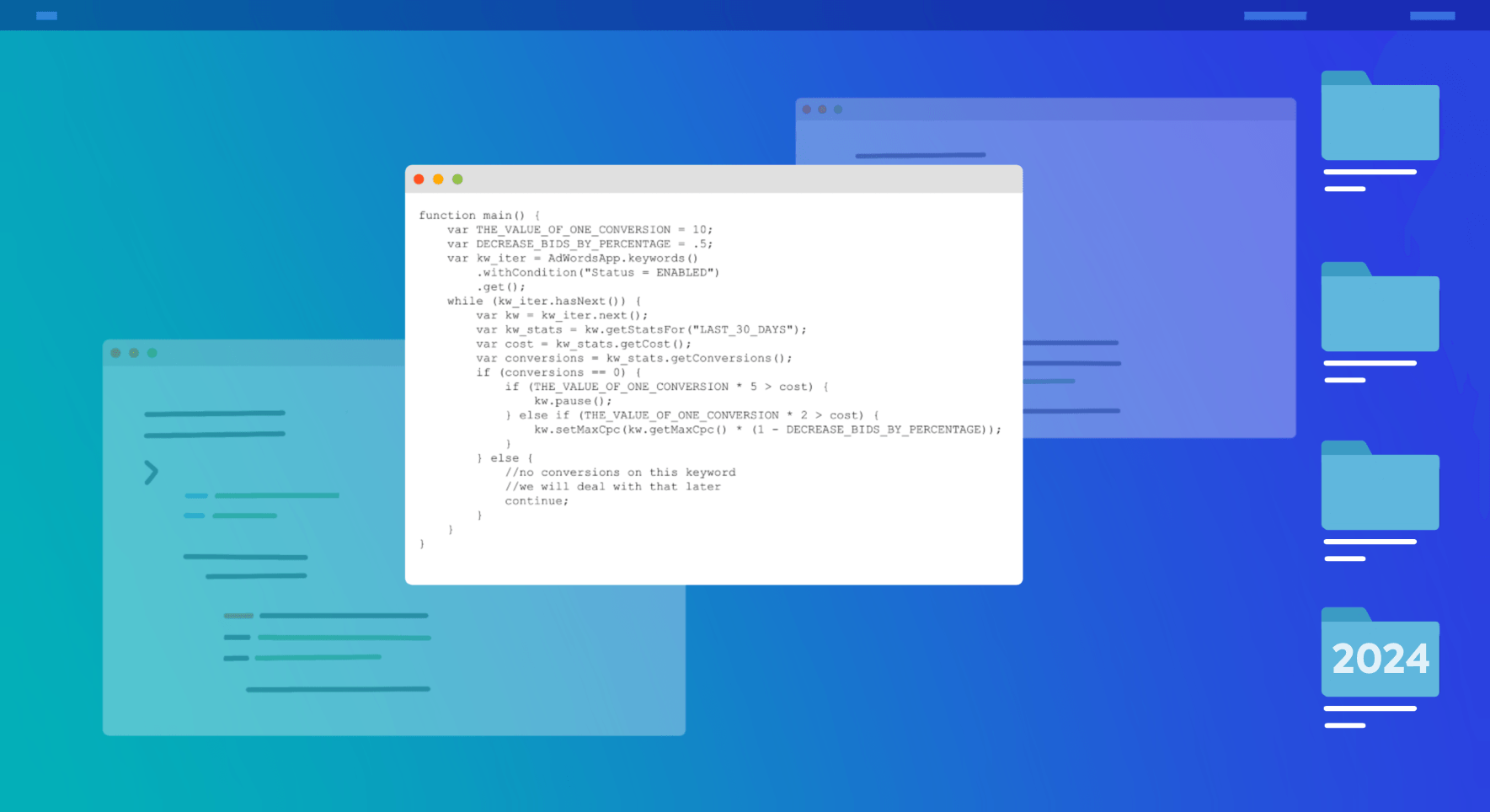Since its launch, Google’s Performance Max (PMax) has been rapidly evolving, with new updates released every month. So how can you use the latest features and strategies to stay ahead of the competition in 2024?
In light of all the changes, Google made significant updates to its PMax documentation in January 2024 to help advertisers build more effective campaigns. And while no doubt useful, especially for those launching PMax campaigns for the first time, the new guide doesn’t explore the more advanced strategies and approaches currently used by cutting-edge PPC pros.
So to dive deep into PMax, we spoke to Adriaan Dekker, PPC Expert and founder of the Google Ads Newsletter, which has more than 28,000 subscribers on LinkedIn. The conversation was hosted by Lunio’s Content Manager, James Deeney.
Adriaan has years of hands-on PPC experience, profitably managing campaigns across 100+ accounts. And since launching his newsletter in November 2022 he’s carefully documented every single minor and major change to the Google Ads platform, making him one of the most recognised and respected voices within the PPC community.
Performance Max in 2024 Webinar
Webinar Timestamps
- 00:00 – Intro
- 05:45 – Microsoft’s Performance Max launch
- 08:15 – Agenda
- 10:25 – Gemini generative AI models for PMax
- 16:25 – PMax’s new “Search Term Insights”
- 19:20 – Using “Search Themes” for PMax
- 22:48 – Using Performance Planner for PMax
- 26:00 – Controlling landing pages with URL rules
- 29:45 – How to exclude any keyword, topic, or placement from PMax
- 32:50 – How to manage PMax brand exclusions
- 35:00 – Top 5 PMax scripts Adriaan uses on a daily basis
- 40:20 – Protecting PMax campaigns from fake clicks & leads
- 48:45 – How to troubleshoot underperforming PMax campaigns
- 51:25 – Q&A with Adriaan
Advertise to Humans, Not Bots
Save up to 20% of your advertising budget by automatically eliminating fake ad clicks across all paid channels.
TL;DR – Key Takeaways
Don’t have time to watch the webinar? Check out the full recap of all the key takeaways and actionable tips below, segmented by topic.
Gemini AI Models for PMax
- Gemini is Google’s long-promised, next-gen General AI model family, developed by Google’s AI research lab DeepMind. All Gemini models were trained to be “natively multimodal” – in other words, able to work with and use more than just words. They were pre-trained on a variety of audio, images and videos, a large set of codebases and text in different languages.
- In November last year, Google announced the launch of AI-powered asset generation and image editing within PMax for the US market. And they will soon be expanding these capabilities with Gemini, meaning PMax can write longer headlines, with sitelink generation set to be rolled out soon as well.
- Google is also soon updating its image generation models to Imagen 2. With this update in PMax, you will be able to create lifestyle images showing people in action. You can also use image editing to add backgrounds with non-identifiable people. And, if you have images that work well already, you will be able to generate more options to scale your creative even further.
- Google stressed that advertisers remain in full control and will be able to review all images suggested for their campaigns.
- Gemini models won’t allow the generation of images of named people, including celebrities and public figures.
- Google also announced an expansion of their partnership with Canva to help support the rollout of new image generation models – this means if you start your design or creative process in Canva, an upcoming Canva integration app will make it easier to publish images directly into your Performance Max campaign.
- When it comes to working with auto-generated assets, Adriaan recommends focusing most of your time and energy on mastering prompt writing. Rather than giving 1 or 2 sentences, provide the Gemini models with as much information as you can e.g. who are your audience? what are their interests? who are your competitors? which tone should the output use?
New PMax Search Term Insights
- In February 2024, advertisers were finally able to see search terms within PMax. Google rolled out new insights which allow advertisers to see search categories and search terms for each campaign.
- Follow the steps below to access PMax search term data:
- Click on a PMax campaign
- Go to the “Insights” tab
- Scroll down to search terms insights
- Click on “View detailed report”
- Expand categories to see search terms
- You can also use a script from Mike Rhodes to automatically pull all your PMax search terms into a spreadsheet.
- Adriaan highlighted that this feature is super useful when it comes to looking for branded search terms within PMax campaigns. If they are present, more work is needed to fully exclude them by adding them as exact match keywords to a standard search campaign.
Using “Search Themes” for PMax
- Search Themes provide marketers a new way to provide additional signals in PMax and expand your ad reach.
- Performance Max uses information from your assets, feeds, and landing pages to inform its ad placement decisions. That means it has the lion’s share of control over your ad targeting. But with Search Themes, you can input your own keywords to fill the gaps in your campaign reach.
- There are two main uses cases for Search Themes:
- 1. There isn’t enough content on your website or landing page to give Google all the information it needs about the search queries you want to be found for.
- 2. You want to optimise PMax campaign performance more quickly.
- It’s also important to note that Search Themes don’t work like the traditional keyword targeting. They’re simply signals that the PMax algorithm can learn from (or disregard) as it sees fit.
- Adriaan highlighted that Search Themes can be used to accelerate performance when adding new products or services to your PMax campaign, which is much easier than adding them as a custom segment.
- For more information on how to minimise the risk of cannibalization when using Search Themes, check out our previous blog.
Using Performance Planner for PMax
- In September 2023, Performance Planner was updated so you can use it with all campaign types including PMax campaigns and Demand Gen as well.
- Performance Planner basically allows you to see what you can expect in return for your ad spend, and also help you identify the point of diminishing returns whereby increasing your ad spend will start to have a negative impact on ROAS.
- There are two basic requirements for using Performance Planner for PMax:
- 1. Your PMax campaign must be currently active, or have been paused fewer than 7 days
- 2. You must not have changed the PMax bid strategy in the past 7 days
- Adriaan recommends using Performance Planner shortly after launching your campaigns, and taking a screenshot of the estimated returns. You can then refer back to this at a later date and compare it against the actual campaign performance.
- Adriaan also highlighted that one important prerequisite for using Performance Planner is having steady, consistent data. If you have big fluctuations in metrics such as conversion volume from week to week, it makes the predictions very unreliable.
Controlling Landing Pages with URL Rules
- In September 2023, Google added “URL Contains” targeting functionality to Performance Max. This feature was already available within Dynamic Search Ads, and it functions the same way within PMax.
- The feature provides marketers with more control over how their ads are served as you manually get to choose which URLs to include to send visitors to the most relevant commercial parts of your site.
- Since a PMax campaign with the Final Url expansion turned on can basically redirect users to every URL possible on your site, non-monetizable pages such as your blogs, and about us page should be excluded. Now, with the new URL rules, you can tell PMax to only redirect users to pages that include commercially relevant URL tokens e.g. /shop
- Typically Adriaan prefers to use the Page Feed tool within PMax rather than URL rules, because it crawls faster than URL rules, meaning key information about sales and discounts etc are shown to potential customers asap.
- When you provide a Page Feed for your PMax landing pages, it helps Google Ads check that all relevant pages are indexed, determine when to show your ads, and where to direct people on your website.
How to Exclude Any Keyword, Topic, or Placement from PMax
- You can use the Performance Max Campaign Modification Request Form to manually exclude any keyword, topic, or placement from PMax.
- You can also use the PMax Placement Cleaner script by Dmytro Tonkikh to automatically get rid of undesirable placements.
- Adriaan commented that he only uses the Campaign Modification Request form in very specific cases. Instead, he prefers to give the algorithms as much data as possible to work with, to help drive better informed optimizations.
How to Manage PMax Brand Exclusions
- People searching your brand will have outrageously good conversion rates compared to almost any other traffic. So if PMax is allowed to cannibalise on branded keywords within your Search campaigns, it’s a big problem.
- It will take credit for those conversions and make it look like your PMax performance is very good, without actually doing anything new.
- You want to ensure you’re distinguishing your bidding and ad creative between prospects still in the awareness stages of the funnel with those who are simply clicking through to purchase, already decided.
- So you should exclude branded terms from PMax and manage them uniquely in Search brand campaigns and in a query-filtered standard Shopping campaign.
- Adriaan mentioned that failing to exclude brand from PMax is an issue he encounters with many of the clients he works with – leading many to overestimate the strength of their campaign.
Adriaan’s Top 5 PMax Scripts
- Here are the scripts Adriaan regularly uses to optimise PMax campaigns:
- PMax Spend Allocation Script by Mike Rhodes – This creates graphs and tables that visualise PMax spend across Shopping, Video, Display, and Search.
- PMax Search Term Insights Script by Mike Rhodes – This exports search terms from your PMax campaigns into a Google Sheet.
- Brand Traffic Analyzer Script by Mike Ryan – This lets you see brand and non-brand volumes – impressions, clicks, revenue, and conversions across PMax campaigns. Ideal for seeing if brand exclusions are working.
- Flowboost Labelizer by Floris de Schrijver – This segments your products into different categories based on performance data. You can then adjust your strategy for each individual category.
- Producthero PMax Labelizer (Paid) – This script is similar to the Flowboost Labeliser, by splitting products into different categories.
Protecting PMax Campaigns From Invalid Traffic
- Lunio’s 2024 Wasted Ad Spend Report was based on a dataset of 2.6 billion paid ad clicks from more than 60,000 ad accounts. When clicks were segmented by channel, PMax had an average invalid traffic rate of 5.96%, compared to 4.72% for standard search and shopping campaigns.
- PMax’s average IVT rate is higher than standard search for two reasons:
- 1. PMax forces the use of Display ads, which inevitably results in a higher volume of invalid clicks.
- 2. Invalid clicks and fake leads are generally cheaper than legitimate ones. And because PMax is algorithmically driven, this can create a negative feedback loop whereby the campaign continues to seek out more and more junk clicks and conversions which never translate into revenue, simply because the acquisition costs are lower.
- 1. PMax forces the use of Display ads, which inevitably results in a higher volume of invalid clicks.
- While the average IVT rate for PMax was 5.96%, on the low end, we see PMax campaigns with IVT rates around 1.5%. And on the high end, Lunio has detected PMax campaigns with IVT rates around 18%.
- PMax campaigns with high IVT rates of 10% or more tend to come from B2B lead gen activity – where spam lead submissions are common.
- It’s no secret that PMax for lead gen is often plagued by low-quality traffic and spam lead submissions. And for brands that were experiencing those issues, Lunio has played a key role in driving up their lead quality via PMax by significantly reducing that IVT rate over time.
- If you’re interested in finding out how much IVT your PMax campaigns are currently bringing in, you can requests a free 2 week traffic audit – where Lunio will monitor and analyse all your clicks coming through Google Ads.
How to Troubleshoot PMax Campaigns
- First, analyse your account and try to understand what’s going on – Is it a campaign-specific issue? A macro issue affecting all campaigns? Is your conversion tracking still working properly? Is there anything out of the ordinary going on inside your account? Dig around and try to get a handle on the situation before attempting a fix.
- Use Mike Rhodes PMax Spend Allocation split to get further insight into which channels most of your budget is going towards. Spend mostly skews very heavily (90%+) towards Search, Shopping, or Video.
- If the issue seems to be PMax itself, then work on further optimising your assets. Improving the quality of your assets is the thing that’s likely to have the biggest impact on your overall campaign performance.
- Consider your campaign structure. Are your products grouped together correctly? Do certain products have very low conversion-rates relative to others? If so, investigate those further to see if you can understand what might account for the difference.
- Try pausing specific products that don’t seem to be converting and see what happens.
- If all else fails, consider whether reverting back dedicated Search, Shopping, and Dynamic Remarketing campaigns makes sense for your brand. Or for lead gen, consider reverting back to a granular Search campaign structure.
Useful Links & Free Resources
Lunio’s 2024 Wasted Ad Spend Report
Adriaan’s Google Ads Newsletter (LinkedIn)
Lunio’s 100k Display Campaign Exclusion List
Gemini models are coming to Performance Max
Performance Max Search Themes: How to Fill Gaps In Campaigns
How to use Google Performance Planner
Performance Max Campaign Modification Request Form
PMax Spend Allocation Script by Mike Rhodes
PMax Search Term Insights Script by Mike Rhodes
Brand Traffic Analyzer Script by Mike Ryan
Flowboost Labelizer by Floris de Schrijver
Producthero PMax Labelizer (Paid)
Advanced pMax for Lead Gen: the Fire & Ice Structure
Advertise to Humans, Not Bots
Save up to 20% of your advertising budget by automatically eliminating fake ad clicks across all paid channels.
